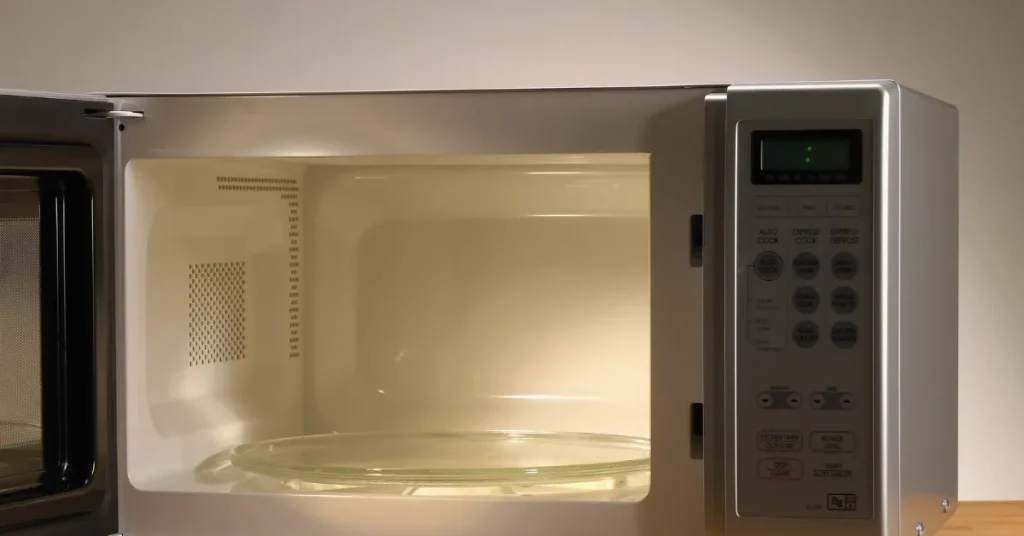The depth of a microwave typically ranges from 12 to 20 inches. This size varies by model and design.
Understanding the dimensions of a microwave is essential for kitchen design and appliance selection. The depth of a microwave must accommodate the cooking needs while fitting into the allocated space.
Compact microwaves often have a shallower depth suitable for small kitchens or dorms, whereas larger models designed for family use or built-in appliances may be deeper.
When choosing a microwave, consider the interior capacity, which dictates the size of the dishes that can be used. Proper ventilation space is also crucial to ensure the appliance operates safely and efficiently.
Always consult the manufacturer’s specifications for exact measurements before purchase to ensure the microwave fits seamlessly into your kitchen layout.

The Standard Microwave Dimensions
When choosing a microwave, size matters. From countertop models to sleek microwave drawers, dimensions can vary.
Knowing the standard sizes helps in planning kitchen space. Your quest for the perfect microwave depth ends here. Let’s dive into the dimensions that fit most homes.
Countertop Models
Countertop microwaves are popular for their ease of use and portable nature. Here are the typical dimensions:
- Width: 15 to 24 inches
- Height: 10 to 14 inches
- Depth: 12 to 20 inches
These dimensions ensure that they fit comfortably on most countertops. Remember to keep clearance space for efficiency and safety.
Over-the-range Units
Over-the-range microwaves serve dual purposes as they save space and act as range hoods. Standard sizes are as follows:
- Width: 24 to 30 inches
- Height: 16 to 18 inches
- Depth: 15 to 17 inches
This design is for installation above the stove, and they typically include built-in ventilation systems.
Microwave Drawers
Microwave drawers offer a modern solution for minimalist kitchens. They slide out smoothly and preserve counter space. See popular drawer dimensions:
| Width | Height | Depth |
| 24 to 30 inches | About 15 inches | 23 to 24 inches |
With these measurements, microwave drawers integrate easily within cabinetry for a seamless look.
Factors Influencing Microwave Depth
Factors Influencing Microwave Depth play a pivotal role in kitchen design. The depth of a microwave can affect how it fits into your space.
Also, it can change how you interact with the appliance. Understanding these factors ensures a seamless fit and ideal usability for every kitchen.
Design And Features
Functional design elements often determine a microwave’s depth. Features like built-in racks or convection capabilities require additional space.
This makes the microwave deeper. Modern designs might include slim profiles to meet compact space needs. Look for models with space-saving features if depth is a concern.
Capacity And Size
A microwave’s capacity, measured in cubic feet, influences its depth. Larger capacity models are generally deeper to accommodate more food. Standard microwaves vary in size from 0.5 to over 2.0 cubic feet. Here’s a quick breakdown:
- Small: 0.5 – 0.8 cubic feet
- Medium: 0.9 – 1.3 cubic feet
- Large: 1.4 – 2.0+ cubic feet
Keep this scale in mind to match your cooking needs and kitchen space.
Brand And Model Variations
Different brands and models boast unique specifications. It leads to variations in depth. Brands like Samsung and LG offer products with unique dimensions.
These cater to distinct design trends or functionality. Always compare model specifications to find the perfect depth. A side-by-side comparison table aids in this selection.
| Brand | Model | Depth |
| Samsung | ME16K3000AS | 15.87″ |
| LG | LMC2075ST | 16.44″ |
Measuring And Fitting Your Microwave

Measuring and Fitting Your Microwave: Before making a new microwave purchase, ensuring it fits perfectly into your space is crucial. Accurate measurements prevent post-purchase headaches and ensure your kitchen remains functional and stylish.
Step-by-step Measuring Guide
Follow these simple steps to measure your space:
- Gather Tools: You’ll need a tape measure and a notepad.
- Measure Width: Note the width of the space where you’ll place the microwave.
- Check Height: Measure the height for adequate clearance.
- Assess Depth: Include extra inches for ventilation.
- Record Space: Write down your measurements clearly.
Tips For Perfect Fit
- Check Door Clearance: Ensure doors can open freely.
- Consider Controls: Ensure easy access to controls.
- Remember Ventilation: Microwaves need airflow.
- Account for Cord Length: Outlets should be reachable.
When To Choose A Custom Installation
A custom installation may be best:
- For Unusual Spaces: Not all kitchens are standard sizes
- For Built-Ins: When a seamless look matters.
- For Maximizing Kitchen Flow: Professionals can advise best placement.
Impact Of Microwave Depth On Kitchen Design
Knowing the depth of a microwave may seem trivial, yet it shapes kitchen functionality and style. A microwave’s depth affects installation options and design harmony. Let’s delve into how microwave depth plays a pivotal role in kitchen design.
Space Considerations
Kitchens often juggle space constraints. A microwave’s depth can determine its fit:
- Countertop microwaves need ample counter space, impacting work area.
- Built-in models nest within cabinetry, aiding in space management.
Measurements are key. Sufficient depth ensures the microwave doesn’t protrude awkwardly or block movement.
Aesthetic Integration
A seamless kitchen design blends technology with style. Microwaves vary in depth:
- Shallow microwaves integrate well, maintaining design flow.
- Deeper units may stick out, breaking visual harmony.
Choose a microwave depth that complements cabinet depth for cohesion.
Functional Accessibility
Ensure everyone can use the microwave with ease. Depth affects accessibility:
| Depth | Accessibility |
| Shallow | Easy reach, suits various user heights |
| Deep | May require stretching, challenging for kids |
Select a depth that allows comfortable reach for the whole family.
Advanced Features In Modern Microwaves

Today’s microwaves boast features that transform kitchens into hubs of technology and efficiency.
They delve beyond reheating to revolutionize cooking with their advanced capabilities. Let’s unwrap some of the innovations enhancing the modern microwave experience.
Smart Appliance Connectivity
Sync your kitchen to your lifestyle with smart appliance connectivity. Modern microwaves come equipped with Wi-Fi capabilities, allowing users to:
- Control settings remotely via smartphone.
- Receive notifications for cooking completion or maintenance.
- Integrate with virtual assistants for voice-controlled commands.
This connectivity ensures your cooking experience is seamless and tailored to the smart home ecosystem.
Convection And Inverter Technologies
Convection and inverter technologies mark a leap in microwave design. Here’s what they offer:
| Feature | Benefit |
| Convection Cooking | Even heat distribution for baking and roasting. |
| Inverter Technology | Precise power control for uniform cooking and defrosting. |
These features emulate a traditional oven’s versatility, paving the way for culinary exploration.
Safety And Energy Efficiency Features
Modern microwaves prioritize user safety and energy conservation. Key features include:
- Auto-shutoff sensors to prevent overheating.
- Child-lock systems to keep little ones safe.
- Eco-mode settings to save power when not in use.
These functions ensure safe operation while promoting a greener, more cost-effective kitchen.
FAQs About How Deep Is A Microwave
What Are Standard Microwave Dimensions?
Typically, standard microwaves have a depth of about 15 to 16 inches. However, depth can vary greatly depending on the model and features, with some models reaching up to 22 inches deep. Always measure your space before purchasing.
How To Measure A Microwave’s Depth?
To measure a microwave’s depth, use a tape measure from the backmost point to the front edge, excluding the handle or control panel protrusion. This gives the cavity’s actual depth, which is crucial for fitting the appliance into designated spaces.
Can Microwave Depth Fit In Compact Spaces?
Compact microwaves, designed with reduced depth, can fit in tight spaces. They typically range from 12 to 15 inches deep, making them ideal for small kitchens or dorm rooms. Ensure you check the specifications for the right fit.
Does Microwave Depth Affect Capacity?
Yes, a microwave’s depth often correlates with its capacity. Deeper microwaves can accommodate larger dishes. However, increased depth might also mean taking up more countertop space, so consider your kitchen layout and cooking needs.
Conclusion
To wrap up, understanding your microwave’s depth is crucial for kitchen space management and appliance compatibility. It ensures you choose the right fit for your cooking needs and countertop dimensions.
Always measure before purchasing to avoid any installation issues. Remember, functionality and fit are key in selecting the perfect microwave.
Resources:
1. https://www.fda.gov/radiation-emitting-products/resources-you-radiation-emitting-products/microwave-ovens
